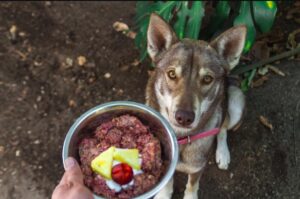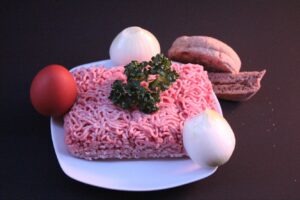Doubts about barf food
We will talk about the question about the BARF diet , which today has many products and supplements that are researched and developed to help keep our pets completely healthy. Of course, for people who have pets, health must be a priority , but we cannot control the nutrition of selected foods in pet food, canned, granulated, or divided into meals on a daily basis. Therefore, interest in cooking our own pets has become increasingly popular, as it is easier for us to choose the right ingredients and nutrients for our pets.
Barf is one of the most popular methods of pet cooking both in Thailand and abroad. Research has shown that barf food helps reduce diseases and physical disorders of pets as well, as well as helps increase calcium, nourish wool, nourish bones, as well as add vitamins directly to our pet's body.
As a result, many questions and doubts about BAFF arise, of which the 10 most frequently asked questions are as follows.
1. What is the barf diet?
Barf stands for Biologically Appropriate Raw Food, which is cooking by mimicking the natural food of animals, which traditionally animals naturally eat fresh meat and eat fruits that can be obtained as food, such as meat, bones, offal, fruits. In addition, barf is considered one of the most suitable foods for pet breeds such as dogs and cats.
2. What is the difference between barf food and fresh food?
Fresh food is food that has not been cooked or heated to more than 40 degrees to preserve its freshness and nutritional value. Whether it's meat. But barf is raw food that has not been cooked and has not undergone any heat at all, for this reason some fresh foods cannot be called barf.
3. Can puppies eat barf food?
Because puppies have a faster growth rate than at other ages, barf feeding is one of the best options to help your puppy grow healthy.
4. What are the benefits of the barf diet?
Since barf is a food that has not been flavored or heated, it is also a traditional food that animals can feed on their own in their original habitat. For this reason, nutrients such as vitamins, minerals, fats, proteins, carbohydrates and minerals are all contributing to the health of our pet's body. The fur is shiny, cheerful, and lumpy.
5. How to start cooking barf?
Since making a barf , it is necessary to understand the nutrition and nutrients in each raw material in order to balance that food with maximum benefit. The most popular starting recipe is the ground chicken recipe, which is a basic recipe with simple ingredients. Chicken, vegetables, fruits, offal, and supplements are crushed to a proportional and proper weight. Then divide the food by quantity or into meals to make it easier to eat at regular times.
6. How much barf should be fed to be appropriate?
Usually pets such as dogs or cats. As adults, we should provide 2-3% of our diet per day depending on our age, breed, and activities for our pets. If our pets are strenuous activities, they should be fed starting at 2.5% of their body weight/per meal and at least 2 barf meals per day.
7. If I switch my pet to barf food, what are the symptoms?
As a result, ready-to-eat foods and barf foods are quite different in terms of nutrition, dietary characteristics, and digestive patterns that need to be adjusted. Therefore, during the first time we switch to a barf diet, our pet may experience vomiting, diarrhea or may not have any symptoms at all, which will disappear on its own within 1-2 weeks.
8. Can pets be fed dry food with barf feed at the same time?
For this reason, grain feeding and barf feeding are quite different. Especially in the part of the different subsystems. For this reason, we should not mix both foods in one meal. It is recommended to separate meals or separate days for dry food, so it is best.
9. What should a good barf diet consist of?
A good barf diet should contain a variety of nutrients such as vitamins, minerals, proteins, carbohydrates, fats, and minerals. We must also consider cleanliness and the raw materials used to ensure that our pets get the most out of their nutrients.
10. What to do when dogs and cats refuse to eat barf food
One of the main reasons why our dog or cat refuses to eat barf is that our pet is old and has been eating kibble and human food for a long time. For this reason, pets are not used to eating barf food in the early stages.
1. Switch to semi-cooked, semi-raw foods
2. Change the taste of food to be diverse
3. Adjust the feeding time or should the pet's eating time should be determined.
While there are many benefits to barf cooking, we need to keep things in mind when it comes to cleanliness, such as the food preparation area as well as pet food containers. It is necessary to clean every time to prevent bacteria and microorganisms. In addition, food should be kept tightly closed and should be stored where it can maintain freshness.
Data Source:
1. FAQ | BARF MEAL READY TO EAT (BARF.) – BONE (https://th.boneandraw.com/)
2. Do-it-yourself cat barf – Kyosane (https://kyosane.com/)
3. Fresh Food VS Barf Food – Kyosane (https://kyosane.com/)
4. Is BARF food really good for dogs? | Dogilike.com (https://www.dogilike.com/)
5. HOW TO START EATING BARF – BONE AN RAW (https://th.boneandraw.com/)







